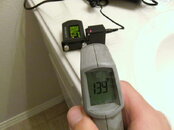You are using an out of date browser. It may not display this or other websites correctly.
You should upgrade or use an alternative browser.
You should upgrade or use an alternative browser.
Hot chargers
- Thread starter ctyhallcoolio
- Start date
Please register or login
Welcome to ScubaBoard, the world's largest scuba diving community. Registration is not required to read the forums, but we encourage you to join. Joining has its benefits and enables you to participate in the discussions.
Benefits of registering include
- Ability to post and comment on topics and discussions.
- A Free photo gallery to share your dive photos with the world.
- You can make this box go away
Rwolf01
Registered
Mine does it too, so I supose it's normal. It's bad practice though. The case and cover are both made out of plastic, so they've basically insulated the PCB. Even if it's only disipating a small amount of power, it is going to get quite toasty.
I tried to take the cover off of mine, but it's glued at the far end, so I could only peek inside. There is a surface mount power component in what looks like an SOT-223 package. Couldn't get the number off of it, but I bet that's where the heat is coming from. Typical max die temperatures on those devices are 100 to 150 degrees C. (212 to 305 F)
The good news is if the bottle neck is in the plastic case, then the temperature rise from case to die is probably not that large. Especially if they used multiple or thicker ground planes in the PCB and grounded copper 'pours' into the unused spaces on the top & bottom layers to act as heat spreaders. That costs little or nothing to do. It's just a matter of thinking about it while laying out the PCB. It won't make the outside case any cooler but it will make the chips run cooler, which is what matters.
Remember the temp sensor in human hands is very non-linear. (I think we evolved them so we can tell when someone is running a fever) Silicon ICs and steel tanks are perfectly happy operating at much higher temperatures than humans can tolerate.
As long as you don't smell smoke or decomposing plastic at the USB connector, it's more of an image problem than a technical one.
I tried to take the cover off of mine, but it's glued at the far end, so I could only peek inside. There is a surface mount power component in what looks like an SOT-223 package. Couldn't get the number off of it, but I bet that's where the heat is coming from. Typical max die temperatures on those devices are 100 to 150 degrees C. (212 to 305 F)
The good news is if the bottle neck is in the plastic case, then the temperature rise from case to die is probably not that large. Especially if they used multiple or thicker ground planes in the PCB and grounded copper 'pours' into the unused spaces on the top & bottom layers to act as heat spreaders. That costs little or nothing to do. It's just a matter of thinking about it while laying out the PCB. It won't make the outside case any cooler but it will make the chips run cooler, which is what matters.
Remember the temp sensor in human hands is very non-linear. (I think we evolved them so we can tell when someone is running a fever) Silicon ICs and steel tanks are perfectly happy operating at much higher temperatures than humans can tolerate.
As long as you don't smell smoke or decomposing plastic at the USB connector, it's more of an image problem than a technical one.
Similar threads
- Replies
- 0
- Views
- 178
- Replies
- 3
- Views
- 327
- Replies
- 31
- Views
- 1,529
- Replies
- 21
- Views
- 1,814




